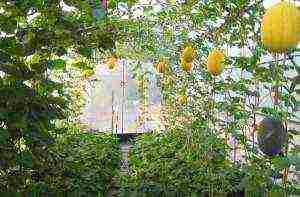Content
- 1 Features of broccoli cabbage
- 2 Stage one. Seed preparation
- 3 Stage two. Seedling
- 4 Stage three. Dive
- 5 Stage four. Transplanting
- 6 Stage five. Care features
- 7 Stage six. Protection from pests and diseases
- 8 Stage seven. Fruit picking
- 9 Cauliflower - varieties
- 10 Cauliflower - growing and care
- 11 Broccoli cabbage - growing and care, storage of broccoli.
- 12 Sowing broccoli seeds for seedlings
- 13 Sowing cauliflower seeds for seedlings (with video)
- 14 Preparing the soil for growing cauliflower seedlings in a greenhouse
- 15 Planting and growing seedlings of Brussels sprouts
Broccoli is recommended by many nutritionists. This Mediterranean culture can grow not only at home, but also in the garden, especially since it is incredibly useful - it contains many minerals and vitamins.
How to grow broccoli. Planting and grooming secrets
Features of broccoli cabbage
This culture is known primarily for its anti-cancer and dietary properties, in addition, it stimulates the process of blood formation. Broccoli is especially beneficial for those suffering from diabetes or heart disease, and because of the high fiber and folic acid content, cabbage is also recommended for pregnant women.
Broccoli cabbage - useful properties
Nutritional value and chemical composition
Note! It is believed that even a "lazy" summer resident is able to grow broccoli. The culture is easy to care for, as you yourself will see by reading the instructions and recommendations given in the article. But first, we advise you to find out what the plant is.
Broccoli is a cruciferous crop whose stems can reach 0.8-0.9 m in height. At the top of the stems, many buds are formed - they are edible. Outwardly, the culture resembles cauliflower, but compares favorably with it in that it forms several heads at once.
Growing broccoli in the garden
There are two types of broccoli, consider them.
- Asparagus... It has a large number of heads of cabbage on thin stems. Edible in this case are just the stems, which are very similar to asparagus (hence the name). Inflorescences can be both green and purple.
- Calabrian... A fairly large head of cabbage, located on a massive stem. Very similar to cauliflower, only the inflorescences are green. Although there are varieties with white inflorescences.
Types of broccoli cabbage
Broccoli Romanesco
The described culture is considered one of the most unpretentious representatives of the family. She should not be shaded because she loves light. Moreover, too small heads can form due to shading. The acidity of the soil should be between 6.7 and 7.4 pH. Potatoes, onions, pumpkins, carrots, cucumbers, legumes and cereals can act as a precursor to the plant.
Express analysis of soil acidity
Note! If cabbage grew on the site, then over the next four years other plants need to be grown there.
The process of growing broccoli, as already noted, is extremely simple. The culture can be grown even on the windowsill, although this is not what we are talking about now. Today you will learn how to grow broccoli in your vegetable garden.
Stage one. Seed preparation
Sift the dried seeds, leaving only the largest of them for planting. The seed treatment procedure consists of several stages, let's get acquainted with them.
Preparing seeds for planting
Step 1... First, immerse the seeds in water, the temperature of which is about 50 degrees, for 20 minutes, and then in cold water, but for a minute.
Step 2. Submerge the seeds in solutions that contain beneficial trace minerals. In parallel, this will serve as additional protection against various infections. First of all, prepare a solution of potassium permanganate (1 g) and boric acid (0.5 g) by mixing the components with 1 liter of water. Then insist the seeds in the resulting product for 12 hours.
Preparing a solution for soaking seeds
After that, immerse them in another solution prepared in advance (dilute 1 tablespoon of wood ash in 1 liter of water, then leave for 48 hours), and leave for another five to six hours.
Step 3. Rinse them with clean water.
Step 4. Refrigerate for 24 hours.
Step 5. Spread the seeds on a clean cloth to dry out slightly. Never overdry!
Step 6. Everything, now you can plant seeds.
This can be started already in March-April. As for the March seedlings, they need to be picked and planted in a greenhouse, after which - in open soil. You can immediately plant the April one in the garden without resorting to a greenhouse.
Sprouted seedlings
To obtain a harvest throughout the season, seeds for seedlings should be sown in two or three periods, the interval between which should be 12-15 days. Thanks to this, you will be able to harvest until the onset of autumn. In addition, in May, seeds can be planted seedlessly, that is, in open soil, but subject to warm weather.
In the photo, the process of planting seedlings in the ground
Stage two. Seedling
You can grow seedlings in a greenhouse or in small boxes. For this, boxes with a height of 25 cm and dimensions of 30x50 cm are suitable.
Wooden box for seedlings
Prepare the soil for seedlings as follows: mix sand with turf and peat in equal proportions, and sprinkle the resulting mixture in the boxes, having previously laid the drainage there.
The best soil for seedlings
It is also recommended to add a little wood ash to the soil to neutralize acidity and provide all the necessary trace elements.
In the photo, ash for adding to the ground
24 hours before sowing, water the soil with a solution of potassium permanganate to avoid the development of a disease called "black leg". But in the future, it is better not to use potassium permanganate - because of it, the acidity of the soil will increase, which will not "like" broccoli.
You can also use small pots for seedlings.
Seedlings in a honeycomb box
If boxes are still used, then for planting the seeds, make furrows 1-1.5 cm deep in about 3 cm increments.The distance between plants within one furrow should be at least 2.5 cm.After planting, maintain the temperature at 20 degrees , after emergence, reduce it to 15 degrees and maintain it at this level until the very transplant. Water seedlings sparingly, once every two days. Do not overmoisten the soil, because this, again, will lead to the development of a "black leg", while a moisture deficit is dangerous for a bad harvest.
"Blackleg"
Note! If the seedlings grow poorly, you can feed them with a solution of potassium chloride, superphosphate, and nitrate (20 g each for a bucket of water). It is important that feeding is carried out only after the second leaf is formed.
We carry out top dressing after the formation of the second leaf.
Stage three. Dive
Diving, as well as transplanting, the described culture does not tolerate well. Nevertheless, many gardeners still recommend diving broccoli and, if possible, planting it in the soil along with a clod of earth. In the greenhouse, diving can be carried out 14 days after seedling formation. But due to the fact that after picking the growth of crops slows down, the procedure can be performed immediately before transplanting.
Dive broccoli seedlings
You need to dive broccoli in two cases:
- if the seedlings are too thick;
- if the seedlings can already be transplanted, but the air temperature is less than 15 degrees (arrows may form with prolonged cooling).
When diving, the stems descend along the cotyledonous leaves. After 30-40 days, the seedlings can be planted.
Stage four. Transplanting
Prepare the beds in advance.
Preparing the beds
In the fall, carefully dig them up and add humus (one bucket per square meter) or fertilizers listed in the second stage (30-40 g each). If the acidity of the soil is increased, then liming before digging (as an option - you can do this in early spring, a few weeks before sowing). With the onset of spring, add compost (10 l / m2) to the beds.
Compost for soil fertilization
Note! Start replanting in the afternoon, preferably in cloudy weather.
Table. Instructions for planting seedlings
|
Step 1 |
Start transplanting when the seedling height is 10-15 cm. |
|
Step 2 |
Water the soil well, then start transplanting. You should first dig up and fertilize the garden as described above. |
|
Step 3 |
Dig holes 8 cm deep with a distance of 30-60 cm. The soil should reach the level of the first leaves, but do not cover them. If we are talking about a miniature variety, then the distance between the pits can be up to 30 cm. |
|
Step 4 |
Monitor soil temperature. Apply a mulch consisting of compost, bark and leaves to keep the soil cool. Pinch off the main root a little to form a good root system afterwards. |
|
Step 5 |
After planting, thoroughly water the soil with water. |
Seedless growing method
In this case, treat the soil in the same way as for seedlings. The seeds are prepared in the same way. Plant in damp and fertilized soil. When the second or third leaf appears, thin out the shoots, after which about 40 cm should remain between the plants.
Stage five. Care features
How to care for broccoli
Water the broccoli daily or every other day, preferably in the evening. Loosen the soil after watering. In hot weather, you can create partial shading, but humidification is more beneficial, so you can place large, low tanks of water next to the beds. In addition, spraying can be carried out using a spray bottle.
Plants may well grow with less watering (even weekly), but the heads in this case will be small, and their taste will be unusual. Various feeding are also useful, one of the possible schemes is given below.
First feeding. It is carried out six to seven days after disembarkation, although it is possible immediately. Urea solution should be used as fertilizer (2 tablespoons per bucket of water - this is enough for about 15 seedlings).
Urea for feeding broccoli
Second. Should be carried out two weeks later with manure diluted with water (1: 4). The resulting mixture is poured under the root.
Third... It is carried out when inflorescences begin to form. It is necessary to use a superphosphate solution (1 tablespoon per bucket of water - this is enough for about 15 plants).
In the photo, the preparation of a urea solution for feeding broccoli
Fourth... Top dressing is applied after the central head is cut.
After each fertilization, carry out hilling and loosening.
Hilling and loosening the soil after fertilization
Although if you cannot carry out four feedings, then nothing terrible will happen, since broccoli is more demanding on moisture than fertilizers.
Stage six. Protection from pests and diseases
Broccoli is quite resistant to these negative factors, and if you followed all the recommendations below, then you have already carried out prophylaxis against a number of diseases. Alternatively, you can use natural remedies. So, if you plant between celery plants, then protect the broccoli from the earthen flea.Dill, in turn, will protect against cabbage aphids, while peppermint will protect against cabbage.
Caterpillar - cabbage
In addition, you can spray the plants with a decoction of tomato tops (3 liters of water per 1 kg).
Tomato tops decoction - cooking
To combat the cruciferous flea, use chemical preparations (for example, "Iskra"), but at least 20 days before the inflorescences are tied.
Video - Features of growing broccoli
Stage seven. Fruit picking
Harvesting Broccoli
You will be able to harvest about three months after planting the seeds, however, the fruits from one plant can be removed throughout the season, since new shoots will grow after cutting.
In the photo there are yellow broccoli sprouts, but you cannot cut them off yet
Collect only green heads. If yellow flowers are observed, it means that the fruits are overripe and unsuitable for consumption.
- Determine the moment of harvest by inflorescences: if they become loose, then the flowers will bloom the next day.
- There are more nutrients in dense fruits, even if they need to be boiled longer.
Rules for cutting broccoli
Start harvesting early in the morning when the flowers are juicy. Early fruits can be frozen or stored for several days in the refrigerator, while autumn harvest is suitable for long-term storage in the cellar.
Video - Planting broccoli in the garden
Secrets of growing broccoli and cauliflower from Raspopov G.F.
Secret - 1. Cruciferous vegetables were the first to appear as soon as man became intelligent and began to engage in agriculture. In Europe, both kohlrabi and broccoli and cauliflower were cultivated even before our era in ancient Greece and Rome. But, the surge in cabbage breeding, and the emergence of many interesting varieties and hybrids, has been noted only in the last 100 years.
In France and Holland, the climate is warmer and the humidity is higher, it is easier to grow these vegetables there than in Russia, so we have 90% or more of the area in our gardens and fields is occupied by ordinary white cabbage, but about it in the next article.

Secret 2 - Kohlrabi is the most unpretentious and early ripening cabbage. It is easy to grow it, but not everyone knows how to cook it deliciously, therefore, having grown and crumbled a couple of times into a salad, or by cutting off a slice and letting the child chew on, the leftovers are fed to the animals.
I like it for its unpretentiousness, productivity and ease of storage in the basement with other root crops.

Secret 3 - In winter, we bring kohlrabi, beets, daikon, leeks and celery root into the house, wash them, clean them and put them on the shelf in the refrigerator for 2-3 days so that these vegetables are always at hand.
And then in all salads, in all side dishes and in all first courses, they will all be used together, it will become a habit. Each of these vegetables contains more than a dozen of the most valuable irreplaceable substances.
And all together they give the body up to a hundred known and unknown building elements that rejuvenate our body, build our cells not from Chinese food additives, but from vegetables from our garden without pesticides.
Secret 4 – It must be distinguished that there are early kohlrabi varieties that should be grown for summer consumption in July, as an addition to Chinese radishes. However, we grow more late varieties of kohlrabi in the field where other cabbages grow, we harvest them in September after light frosts, then they are especially sugary and contain more minerals and vitamins.
Secret 5 - The main varieties of kohlrabi. The best early variety of Czech selection is Atena, and F1 hybrid Caratago.
Vienna White 1350 is the most common and unpretentious variety. Of the large ones weighing more than 2 kg - Czech Moravia, medium early, and the best late - Violeta, Kossak F1 and Gigant, are well stored.
Secret 6 - We grow kohlrabi, like all cabbages, only through seedlings, early varieties from April in a greenhouse, and we plant 30-45 day old seedlings at the beginning of May near the house, so that we can cover in severe frosts. And the late varieties are planted in June, after all other cabbages.
There is only one danger - a spring cruciferous flea, eats seedlings from seeds completely. Therefore, nothing happens without pyrethroids, you have to spray the planted seedlings a couple of times.
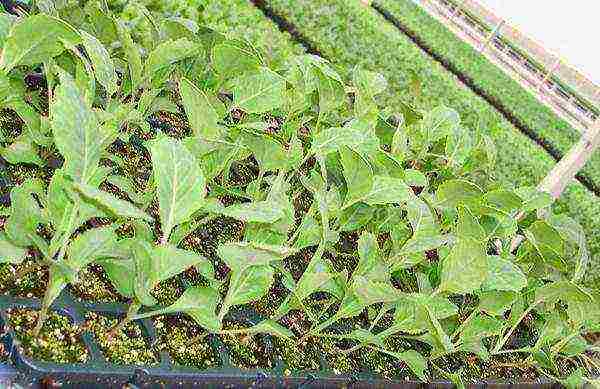
Secret 7 - When I learned to apply ACC a few years ago, the first culture that made me love this method was kohlrabi. Look at the June photos, which leaf is in kohlrabi 3 weeks after planting the seedlings. And a month later, huge kilogram heads of cabbage appeared. Therefore, I use AKCh on broccoli and on kohlrabi plantings every 10 days, then these cabbage easily tolerate the stresses from heat, drought and lack of nutrition in the soil.
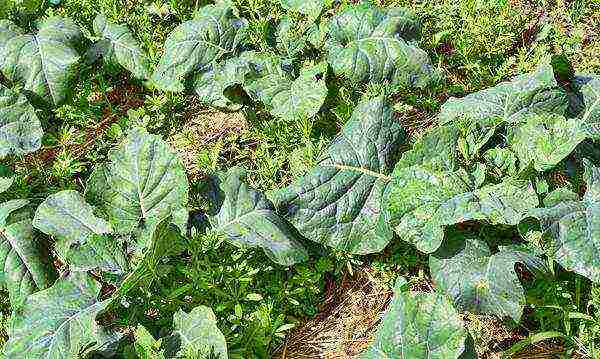
Secret 8 - Like all cabbage kohlrabi, a soil rich in organic matter and nutrients is needed, but the main thing is constant moisture. Without moisture, no cabbage will grow.
If the soil is not infected with keel, that is, the soil contains calcium, molybdenum and boron, the soil is not acidic, and the flea has not eaten the young leaves - you will always get a kohlrabi harvest. Our sourish soils should be calcified in the fall.
Secret 9 - There is nothing more important for cabbage than keel prevention, and for seedlings, protection from black leg and powdery mildew.
At the beginning of my vegetable growing, up to 90% of the crop perished from these diseases. Therefore, I switched to imported seeds treated with fungicides and I grow seedlings only in a reliable peat substrate.
I never use fertilizing with manure and herbal infusion at the seedling stage, only modern solutions or crystals for cabbage. But this is for colored and late white cabbage.
Naturally, you don't need so much kohlrabi, I buy a little Russian seeds, I bubble them in the ACC, and add trichodermin to the seedling substrate. And still, up to 5% of plantings are affected by the keel, but usually by the end of summer, when the head of cabbage is formed.
Secret10 - All cabbage, including kohlrabi, respond perfectly to watering seedlings a week before planting and after planting with calcium nitrate, and it is imperative to feed it with a chelated complex of trace elements containing boron and molybdenum.
Secret 11 - When the seedlings grow to 4-5 true leaves, I intensively mulch the beds with manure. Cabbage is not afraid of fresh manure during this period, responds to it with rapid growth of foliage and subsequent high yield.
I cover each root with loose straw manure of any degree of decomposition, which is at this time, up to a bucket of 1 square meter. since July, this manure is covered from the sun by cabbage foliage, there is a lot of moisture, it is all permeated with white roots.
By autumn, the manure is all in the holes of soil engineers, you take it in your hand like cotton wool, all the nutrients are consumed without loss. For early varieties in the garden beds, the best planting pattern is 15 cm between the plant and 25 cm between the rows.
Secret 12 - Broccoli. It is not always possible, it is easier to grow it in color, but you need to know its secrets. Cauliflowers do not tolerate heat and drought, so we plant early varieties of broccoli with 45 day old seedlings at home in early May and water regularly.
If you feed it with microelements, calcium nitrate, mulch it with manure and spray it every 7-10 days, then in June it gives a dense head of a large size, and after a couple of weeks you can cut off a dozen small, but equally tasty heads from the leaf axils.
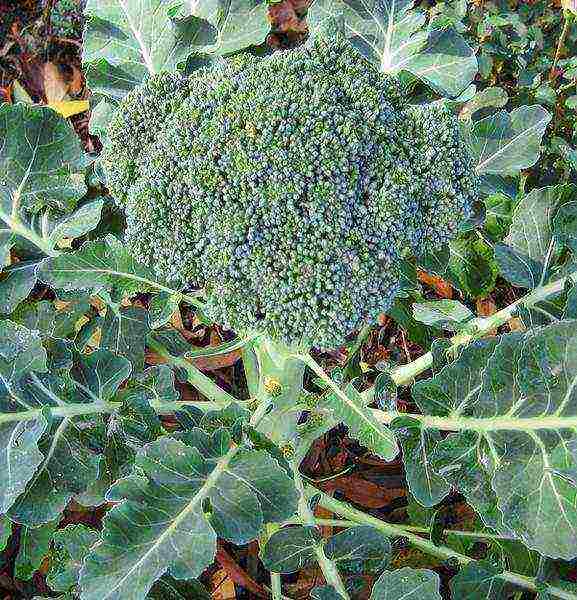
Secret 13 - There is no place for late varieties in our garden, in the field it did not work out on the poor "collective farm land".
But when my land became alive, it stopped plowing with a plow and received a lot of organic matter and ACC, then broccoli planted in the field at the end of July, watered with water only a couple of times after planting, mulched with manure at the end of August and until the end of September gives us a myriad of large heads.
Every 3 days last year, we collected 2 buckets from an area of 0.5 acres, filled all the shelves of the freezer, distributed to all relatives and friends. In winter, they ate every day, and they ate today on March 16th.
Secret 14 - Broccoli Varieties. The homeland of broccoli is Italy, where its late varieties, for example, Calabrese.I sometimes manage to get imported late hybrids that give beautiful large heads in the fall. From the well-known early varieties for our zone - Vitamin, Linda, Tonus, Lazar F1.
Secret15 - All summer we have a conveyor belt of broccoli, we do not store for more than three days, we consume only raw in summer. Finely mode, scald with boiling water, it becomes emerald green, and is added to all summer salads: with radishes, cucumbers, tomatoes and peppers, lettuce, onions. On weekends on a large table, broccoli is sometimes prepared as a culinary delight. Recipes are visible from numerous photos, you need to include imagination.
In winter, we eat frozen broccoli in the same way. We never do any canned food with it. We can only preserve tomatoes and peppers.
Secret 16 - Broccoli for us, especially in its raw form, is a storehouse of B vitamins and very active biological substances.
Only broccoli, as well as Brazil nuts, can meet our selenium needs. Serotonin is also most abundant in broccoli, and it is a hormone of happiness and good mood, so families who constantly consume broccoli live together and live long.
In addition, they have good eyesight, due to the special antioxidants that protect the retina.
Broccoli does not give allergies, we give it to children from 6 months of age.
Secret 17 - Cauliflower Previously failed. Now it grows annually both in the beds near the house and in the open, in a larger field among other cabbages.
It's just that the earth has become alive, with a very active and diverse soil biota, and active soil engineers, so our cauliflower endures all climatic stresses more easily, the growing season ends faster.
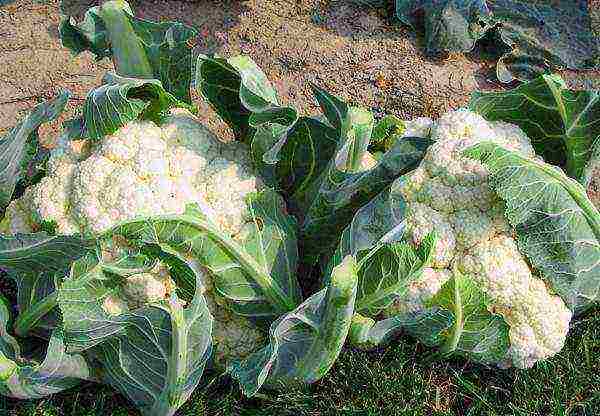
Secret 18 - Cauliflower originated from humid warm places in southern Europe. In the Novgorod region, she lacks the sum of active temperatures in summer, cold June nights are bad for her, long daylight hours, and July heat with dry air are even worse.
Our poor sour loams are not for her. The soil for this cabbage must be prepared almost like for cucumbers. In the fall, lime and add organic matter.
Secret19 - Varieties. The birthplace of cauliflower is Asia Minor. For the north, it is more difficult to adapt. Now in Europe there are varieties with bright purple and bright yellow heads.
There are many varieties with the original star-shaped head, the Romanesco group, this is a hybrid of colored and broccoli, but they grow poorly here, more precisely, they give a very small head, although tasty and healthy.

For Russia, from the late varieties there is Autumn Giant, mid-season ones - Snow Globe, Robert, early ones - Snowball, Movir, Guarantee, F1 Hybrid Malim but.
Secret 20 - Seedlings. Using cauliflower as an example, I will tell you more about seedlings.
Seeds are selected only large and bubbled in ACC. The substrate is the best imported peat with perlite and fertilizers.
There will be single keel spores in a poor-quality substrate, and already at the seedling stage you will see keel instead of roots. And then the black leg.
Strictly one grain at a time with tweezers, we lay out the seeds in special seedling combs for cabbage. They are cone-shaped, so it is more convenient to take out the seedlings.
Do not use peat pots, dense peat penetrates the root slowly, the planted seedlings dry out in one day without watering.
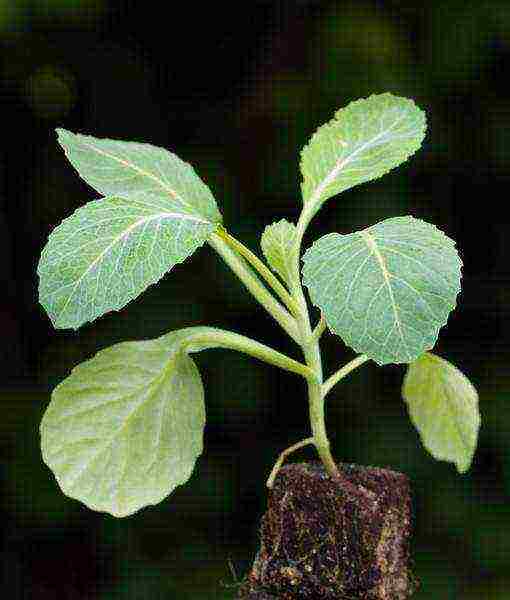
Secret 21 - Cabbage is not a cucumber or a tomato. Seedlings require bright sun, cabbage does not grow on the window. Therefore, we grow early varieties from April 1 in a polycarbonate greenhouse and plant in the first decade of May, near the house, to cover in case of frost.
Late varieties grow from late April to early June just outside, covered with lutrasil at night. On the street, you need to water them daily and spray them with pyrethroids from fleas and butterflies.
Sometimes it is necessary to bring pallets with seedlings into the greenhouse at night. In the afternoon, take out in the sun.
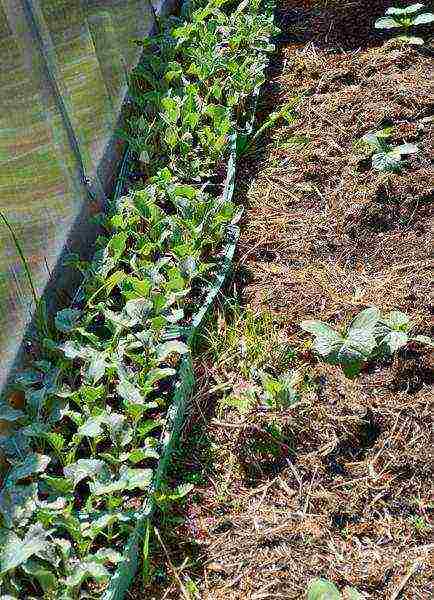
Secret 22 - Seedlings should be fed weekly with complex liquid fertilizers with trace elements for cabbage, you can halve the recommended concentration.
Cauliflower is capricious, does not grow without dressing.A week before planting, I feed separately calcium nitrate and AKCh. But it is more important not to overdry, not overheat, not freeze. -1 g is already fatal for this sissy.
Take it out of the greenhouse, where the seedlings basked for a week, in the bright sun - it will burn. Plant it densely, closer than 3 x 3 cm - it will get sick with a black leg or powdery mildew.
Secret 23 - I plant all cabbages in the field on double rows every 40 cm between the lines and a wide row spacing of one meter. But the distance between plants depends on the variety. For kohlrabi it is sometimes 15 cm. For broccoli it is usually about 40 cm. It's quick and easy.
Secret 24 - Predecessors. All cabbages, especially cauliflower, do not tolerate planting after crucifers.
Diseases accumulate quickly, keel spores persist for 2-3 years.
In my field, usually after cabbage, there are beets (carrots), then potatoes, under it are brought in with manure, then cabbage, which I cover with manure a couple of times since June.
There is more than enough organic matter and there is enough nutrition, but with an excess of nitrogen, a deficiency of potassium, magnesium, phosphorus may appear.
I look at the growth, sometimes I put AVA glasses (phosphorus and trace elements) in the hole, but ideally I alternate feeding with calcium nitrate and potassium monophosphate. Phosphorus is needed to form a "flower" - a head.
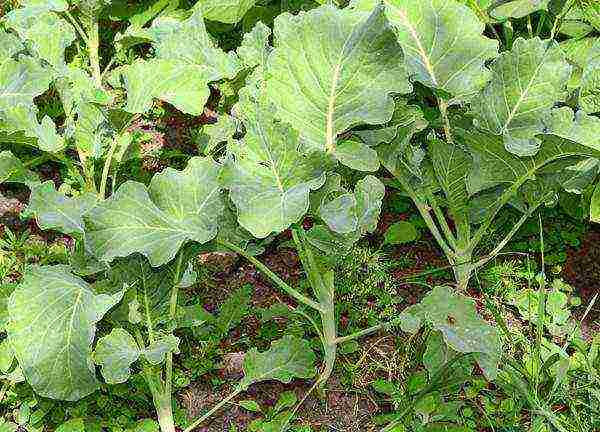
Secret 25 - If a keel appears on the cabbage, I return the cabbage to this place no earlier than 5 years. And when planting potatoes or beets, I treat this place with herbicides from the annual rape. For these crops, herbicides are commercially available.
Any annual cruciferous weed also becomes infected with keel, is its carrier, and you will never get rid of it. Only 3 years of herbicide application will sanitize the soil. Weeding is not enough, the roots always remain.
Secret 26 - On cabbage with cereal weeds, I don't really fight, I cut the row spacing with a trimmer fishing line and loosen it at the root with a flat cutter. The main thing is that the weeds are not higher than the cabbage, do not shade it, but shade the soil. A small amount of weeds will even improve the yield.
Secret 27 - I enjoy the moderately warm and rainy end of August and September. In such weather, late imported cauliflower hybrids perform wonders, especially with the use of ACC.
Huge burdock leaves grow to the waist. And suddenly a flower embryo appears, in cool weather it grows and grows, but remains very dense.
After the frost, I pull up the cabbage by the root, put it in a cold basement, sprinkle the root with wet sand, and the head of the cabbage continues to fill up for another month.
But we freeze the main crop. This year we bought a second freezer. Especially for broccoli, cauliflower and asparagus beans. And the first freezer goes under the strawberries, raspberries and honeysuckle.
Secret 28 - There are too many recipes for cooking cauliflower, they know how to cook it in all European countries for three thousand years.
In any form, cabbage is valuable for its amino acids, fiber, B vitamins, which are not particularly destroyed during heat treatment.
Only it contains a lot of phytosterols - plant competitors of cholesterol. But this cabbage is especially valuable for the presence of isothiocyanates (sulforaphane), and indoles, which protect us from cancer.
It is important for us that if you eat hearty cauliflower as a side dish, you begin to consume less bread and starchy vegetables, and more fresh herbs in the form of salads.
Jun 16, 2015
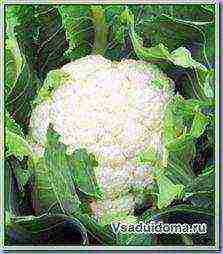 Cauliflower consists of a head - a shortened multi-branched flower stem (some scientists believe that this is an overgrown stem), which is a high quality dietary food.
Cauliflower consists of a head - a shortened multi-branched flower stem (some scientists believe that this is an overgrown stem), which is a high quality dietary food.
Cauliflower is a very healthy vegetable, as it contains crude protein (2.4%), vitamins C, B1, B2, PP, mineral salts of iron and phosphorus. Consumed after cooking; has a delicate, very satisfying pulp, which is prepared according to special recipes.
A variety of cauliflower is broccoli (see broccoli below) - a plant with a loose, pale green or purple head. Broccoli is superior to cauliflower in terms of protein content and taste and merits.
The biological features and properties of cauliflower are the same as those of white cabbage, but it should be borne in mind that the most favorable conditions for the formation of a dense head of high dietary quality and good presentation are at a temperature of + 15-18 ° C. At elevated temperatures, it forms a loose head.
Cauliflower - varieties
Cauliflower varieties are divided into three groups: early - Early Gribovskaya 1355, MOVIR 74 with a growing season of 95-100 days, which are cultivated in spring culture; medium - Patriotic; late - Adler winter 670 and Sochinskaya (growing season more than 130 days). Grown in autumn culture.
Cauliflower - growing and care
When growing cauliflower in the early spring period, the main attention is paid to the growth of leafy mass, which is capable of forming a head with a diameter of 15-20 centimeters and weighing 300-800 grams.
In the summer-autumn period, the head of cauliflower can grow up to 20 centimeters in diameter and weigh over 1 kilogram.
Cauliflower is cultivated through seedlings, which are best grown in nutritious pots, since part of the root system is lost during picking and transplanting, which leads to a delay in head formation.
Techniques for growing cauliflower seedlings do not differ from white cabbage (more details here - Growing and caring for white cabbage). At the same time, they make sure that the temperature during the day does not exceed + 18 degrees.
Seedlings are hardened 10-12 days before planting. The day before, potless seedlings are watered abundantly, potted seedlings - moderately. Seedlings are planted in open ground in the first decade of April.
Planting method - wide row with a row spacing of 70 centimeters or two-line tape 90 × 50 cm (distance between tapes is 90 centimeters, between lines in the tape - 50 centimeters).
Seedlings in a row are planted with a distance of 30 centimeters. For its better survival rate during planting and after its completion, watering is used - 1.5-2 liters of water for each plant. After planting, watering is applied 2-3 times a week for 10-12 days until the seedlings are fully established.
After the seedlings take root, the row spacings are loosened to a depth of 6-8 centimeters, the subsequent ones are carried out to a depth of 8-10 centimeters with hilling, which contributes to additional root formation and plant resistance.
The first feeding of cauliflower is used 10-15 days after planting: slurry diluted 1: 5, or chicken droppings (1:10) with the addition of 30 grams of ammonium nitrate per 10 liters of water.
The second time the cabbage is fed 10-15 days after the first: mullein 1: 5 and complex fertilizer, nitrophobic or nitroammophos (30-40 grams per 10 liters of water).
The third top dressing is used at the beginning of the formation of the head: mullein, diluted 1: 5, with the addition of 50 grams of granular superphosphate per 10 liters of water. 3-4 liters of solution are consumed per 1 m2.
To obtain a cauliflower head of high commercial quality, it is shaded by breaking 2-3 leaves or tying them together above the head.
Harvest the cauliflower as it ripens. When cutting the head, 4-5 cover leaves are left, which protect it from contamination.
For summer-autumn cultivation, cauliflower seedlings are grown in nurseries up to 35-40 days old and planted with a lump of earth in August. In this case, the formation of the head takes place in September-October for 50-60 days. The cultivation technique of cauliflower in the summer-autumn period does not differ from the early spring.
Cauliflower can be grown (when a cold snap sets in in the fall, and the head has not formed).For growing, heads are used at least 6-7 cm in diameter, while the roots are added dropwise, and the plants are completely shaded.
Growing should take place at a temperature of + 2-5 degrees and a humidity of 90% (for this, the soil is sometimes moistened). The growth of the head takes place within 50-60 days due to the plastic substances of the leaves and stumps. During the growing period, the head increases 2 - 3 times and is realized as it grows to the required size.
Broccoli cabbage - growing and care, storage of broccoli.
The heads resemble cauliflower in shape, but contain more vitamins, mineral salts, protein and carbohydrates.
Broccoli is used in salads, soups, side dishes and main courses boiled and fried.
Recently, I have been successfully growing an early ripening variety of broccoli Tonus, which is characterized by amicable ripening (harvested 35 - 40 days after planting).
Growing broccoli
Broccoli should be placed after onions, cucumbers, peas, or carrots.
In the fall, under digging, 4-5 kg of humus and 40-50 grams of superphosphate and potassium chloride are introduced per square meter. Ammonium nitrate is applied in the spring at 30-40 g per square meter per hole before planting seedlings and 10-12 days after the seedlings take root. You can alternate fertilizing with mineral fertilizers with organic - mullein or chicken droppings, diluted 1:10.
During the growing season, apply moderate watering and loosening. Unlike cauliflower, broccoli is not shaded.
Harvest broccoli when the head reaches 15-25 centimeters in diameter. The head is cut off early in the morning. It is undesirable to be late in harvesting, since when buds appear, the nutritional value of cabbage decreases.
After cutting, the plant can additionally form 10-15 heads 5-10 centimeters in diameter.
Cut heads keep well in the refrigerator.
Below are other entries on the topic "Cottage and garden - do it yourself"
Cauliflower (photo) - growing in the open field: How to grow cauliflower in ... Cauliflower variety Violet (photo) - reviews, planting and care: Growing cauliflower variety Violet Tsvetnaya ... How to grow two crops of cauliflower: Two crops of cauliflower for ... Growing cauliflower and broccoli in North Ossetia: Broccoli and cauliflower - ... How to grow cauliflower: care, how to fertilize and the best varieties: Growing cauliflower - varieties ... Growing broccoli by seedlings and seedless way: So that broccoli does not outgrow and ... Re-planting broccoli and cauliflower: Sowing cauliflower and broccoli ...
Subscribe to updates in our groups.
Let's be friends!
Sowing broccoli seeds for seedlings
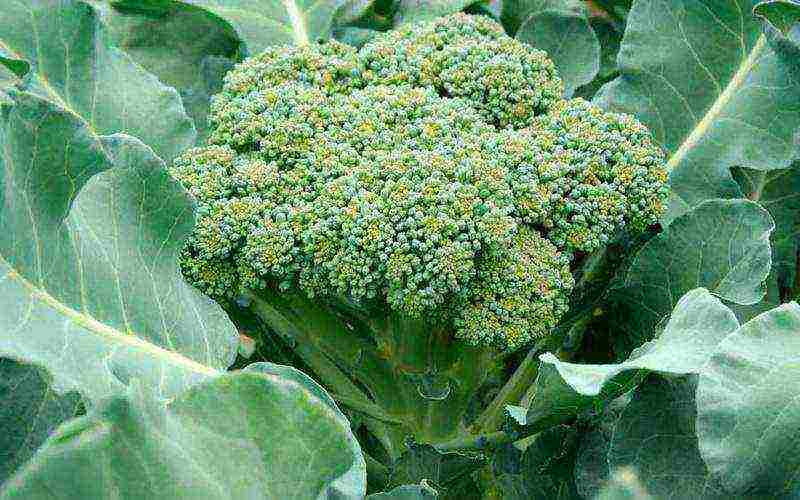
Broccoli cabbage in the photo
The high-vitamin crop ripens in early June - two weeks earlier than cauliflower. Broccoli is undemanding to heat, at temperatures above 25 ° C and below 10, dry air and soil, the yield and quality of products are sharply reduced. For growing broccoli seedlings, the optimum temperature for growth and development should be 16-25 ° C. The culture can withstand frosts and minus 7 ° C.
To get an early harvest, broccoli is grown as seedlings, just like cauliflower. When planting broccoli seeds in boxes on March 8-12. Seedlings are planted in the ground in late April - early May in a well-watered garden bed. Water so that the topsoil 30 cm deep is moistened. The distance between the rows when sowing broccoli seedlings should be 45-50 cm, and between the plants - 30 cm.
To receive production until late autumn, seeds for seedlings are sown at several times at intervals of 15 days, the last sowing date is June 20. Seeds can be sown directly on the garden bed, followed by thinning.
Broccoli grows on soils well seasoned with organic and mineral fertilizers. To grow strong broccoli seedlings, 1 bucket of compost soil, 3 tablespoons of garden mixture, and a half-liter can of ash are added to 1 m2 of the garden.
Sowing cauliflower seeds for seedlings (with video)
If you want an early harvest of cauliflower, grow it early (March, April) with seedlings.
During these terms, cauliflower is planted in the greenhouse for seedlings of varieties:
Warranty,
Movir 74,
Snowball,
Early mushroom 1355.
The soil for growing cauliflower seedlings should be lighter than for other types of cabbage. Seedlings of cauliflower grown in a greenhouse are transplanted into open ground, depending on weather conditions, in April, and under a film shelter - 10-15 days earlier.
Before growing cauliflower seedlings, you need to prepare the soil: this is done in the same way as for cabbage varieties. Cauliflower is usually grown in the first year after the application of manure, while the doses of mineral fertilizers and the timing of their application are the same as for cabbage. It should be borne in mind that an excess of nitrogen leads to a decrease in the density of the heads.
When sowing cauliflower for seedlings, remember that it is sensitive even to short-term water and nutrient deficiencies. During the cultivation of cauliflower seedlings in the greenhouse, top dressing is done (two weeks after germination) using the Agricola-1 fertilizer solution. Seedlings are planted in a permanent place after at least 4 true leaves have formed.
A good harvest is possible when sowing seeds for seedlings on a bed under a film in the third decade of April.
Seeds are sown at a distance between rows 10 cm, in a row - 5-6 cm. After sowing, the bed is covered with a covering material or low arcs are placed and a plastic wrap is stretched over them. On warm days, the film is slightly opened or completely removed, otherwise the seedlings will quickly stretch out. It should not outgrow, as in this case, "button" sockets may form.
To obtain a harvest of cauliflower at a later date (harvesting of which is planned for the end of September - October), seeds are sown in May (first - third decades) in the same way. Seedling care is the same as for earlier sowing dates. First, seedlings are grown in a small area of the garden, and then, in June, they are transplanted to a permanent place.
Seedlings are planted on ridges up to 100 cm wide. After digging, 1 glass of wood ash is introduced per 1 m2, 1 tbsp. spoon of superphosphate and nitrophosphate and 2-3 kg of organic fertilizers (manure or vegetable humus). After that, the bed is dug to a depth of 10-12 cm. The seedlings are planted according to the scheme: 50 cm between rows, in a row - 25-30 cm.
The video "Sowing cauliflower for seedlings" shows all the main agricultural techniques:
Preparing the soil for growing cauliflower seedlings in a greenhouse
Cauliflower grows well on loose loam or sandy loam with a high humus content. But in any case, you cannot plant plants in freshly dug soil, you should wait at least a week. Loose soil should be somewhat compacted. Cauliflower (like cabbage) loves compacted, prepared soil a few months before planting.
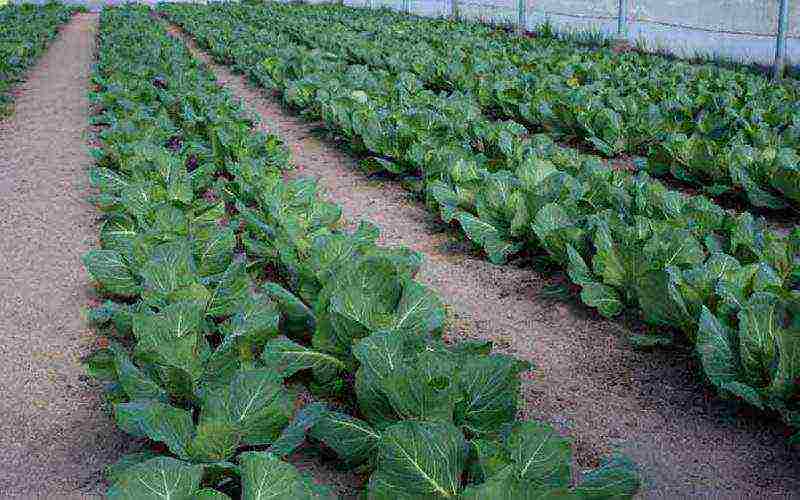
Growing cauliflower in a greenhouse in the photo
The acidity of the soil in the greenhouse should be neutral or slightly acidic. Lime is applied in the fall of the year preceding planting. If horsetail, oxalis, sorrel grow on the site, this is an indicator of acidic soil. Doses of lime, depending on the acidity and severity of the soil, range from 0.3 to 0.5 kg / m2. When preparing the soil, the most effective way to reduce acidity in the greenhouse is to first sprinkle the soil with lime or ash evenly, and then sprinkle it with manure (mullein), and then dig it up. Cauliflower loves high doses of humus or compost. It should be borne in mind that the soil and the fertilizer used affect its taste. Cauliflower reacts positively to boron and molybdenum feeding in the seedling phase.
Fertilizer for cauliflower is applied as well as for white cabbage. However, better, warmer places are allocated for cauliflower.In the spring, 1 m2 is applied: 6-8 kg of manure or compost, 20-25 g of double superphosphate, 30-35 g of chloride or potassium sulfate, 0.5 teaspoon of boric acid, ammonium nitrate 25-30 g or urea 15 g / m2. To save fertilizers, some of them are introduced into the planting holes, thoroughly mixed with the soil. It is useful to add wood ash to potash fertilizers, especially in planting holes.
Planting and growing seedlings of Brussels sprouts
Before growing seedlings of Brussels sprouts, the soil should be prepared in the previous autumn, with the addition of a layer of manure and compost in the amount of one and a half buckets per 1 m2. Leave the soil exposed to snow and wind, and then loosen it to a depth of 2.5 or 5 cm in the spring, adding fish droppings at a rate of 120 g / m2. Instead, you can use a mixture of one part potash sulfate, four parts bone meal at 120 g / m2.
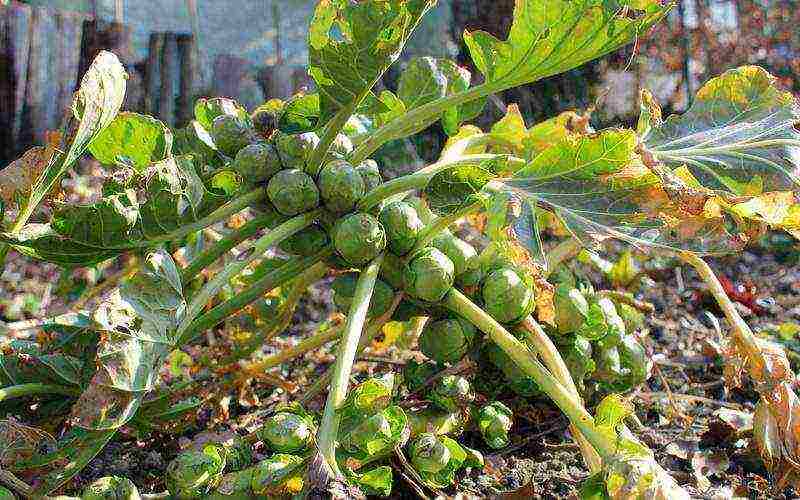
Growing Brussels sprouts in the photo
Planting of Brussels sprouts for seedlings is carried out in a box or in a pot in March or April, in holes no deeper than 12 mm at a distance of about 15 cm from each other. They should be covered with plastic bags to keep them warm and protected. When they begin to sprout, they need to be thinned out to give them room to develop.
Immediately after planting potted seedlings, loosening is done, when planting potless - no later than 3-5 days.
You need to start planting when the seedlings reach 10-15 cm in height. You need to plant in such a position in which they will be ready to ripen, you should continue to plant until mid-August. It will be good if you water them generously the day before replanting. Plant seedlings of Brussels sprouts at a distance of 90 cm from each other, so that their lower leaves are above the soil level. After the plants are transplanted, they need to be watered well. As they grow, you may need to post them in high winds.
One of the most important activities for growing seedlings of Brussels sprouts, like all other species of plants in the Cabbage family, is picking. Its purpose is to maintain the soil in a loose state in order to create a favorable water and air regime for the growth and development of plants.
Seedlings of Brussels sprouts should be planted in the ground in late May or early June.
Rate the article:
(0 votes, average: 0 out of 5)


